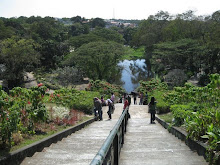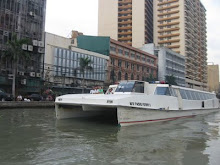
The Black Nazarene is a life-sized, dark-skinned statue of Jesus Christ that a priest bought in Mexico, carved by an Aztec carpenter. The image is now enshrined in the minor basilica in Quiapo, Manila, Philippines and the day on which devotees go to the church is Friday. The procession, and the accompanying
Feast of the Black Nazarene, takes place every year on January 9. It is usually the single largest festival of the year in the Philippines.
The statue was brought to Manila by the first group of Augustinian Recollect friars in May 31, 1606. The image was enshrined at the first Recollect church in Bagumbayan (now part of the Rizal Park), which was inaugurated on September 10, 1606, and placed under the patronage of Saint John the Baptist.
In 1608, the second bigger Recollect church dedicated to San Nicolas de Tolentino(Saint Nicholas of Tolentine ) was completed inside Intramuros (where the building of the Manila Bulletin now stands), where the image of Nuestro Padre Jesús Nazareno was transferred. The Recollect Fathers then vigorously promoted devotion to the Suffering of Our Lord represented by the image that in fifteen short years, the Cofradia de Jesús Nazareno was established on April 21, 1621. The confraternity obtained Papal approval on April 20, 1650, from His Holiness Pope Innocent X.
Sometime in the year 1787, the Archbishop of Manila, Basilio Sancho de Santas Junta y Rufina, ordered transfer of the image of the Nazareno to the church in Quiapo, again providently placed under the patronage of Saint John the Baptist.
The image survived the great fires that destroyed Quiapo Church in 1791 and 1929, the great earthquakes of 1645 and 1863, and the destructive bombing of Manila in 1945 during World War II.
Recently, however, in 1998, a replica of the original Black Nazarene was first paraded due to the repeated damages on the statue. Today this replica is still used in processions while the original rests inside the church, and other, even smaller replicas can be found in other churches.
The devotion to Nuestro Padre Jesús Nazareno has attracted an even bigger following. Its popularity, which initially spread to the northern and southern provinces of Luzon, spread over time throughout the country.
The uniquely Filipino devotion to the Black Nazarene merited the sanction and encouragement of two popes: Innocent X in 1650, with a Papal Bull canonically establishing the Cofradia de Jesús Nazareno, and Pius VII in the 19th century, by granting indulgence to those who piously pray before the image of the Black Nazarene of Quiapo.
Today, despite the rough-and-tumble that usually accompanies the thrice-yearly procession of the image, the Filipino people's devotion to God in the special appellation of Nuestro Padre Jesús Nazareno continues to flourish and shows no sign of warning; death, wounds, bodily pains and physical discomfort notwithstanding.
For more than 200 years, the statue has been placed on a gilded carriage every January and pulled through the streets of Quiapo by male devotees dressed in maroon. People who touch the Nazarene are reported to sometimes be healed of diseases. Catholics come from all over Manila on the chance that they will be able to get close enough to touch the image and perhaps receive a miracle. They also throw towels to the people guarding the statue and ask them to rub the towel on the statue in hopes of carrying some of that power away with them.
Source: Wikipedia.org
Related link:
Señor Enrique,
Sidney's black nazarene procession on
2006 and
2007


























